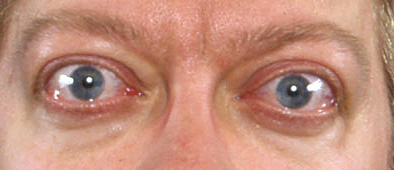In iodine-sufficient parts of the world, the prevalence of overt hyperthyroidism is 0.2% to 1.3%.[11]Taylor PN, Albrecht D, Scholz A, et al. Global epidemiology of hyperthyroidism and hypothyroidism. Nat Rev Endocrinol. 2018 Mar 23;14(5):301-16.
http://www.ncbi.nlm.nih.gov/pubmed/29569622?tool=bestpractice.com
Graves disease is the most common form of hyperthyroidism in most areas of the world, including the US.[12]Wiersinga WM, Bartalena L. Epidemiology and prevention of Graves' ophthalmopathy. Thyroid. 2002 Oct;12(10):855-60.
http://www.ncbi.nlm.nih.gov/pubmed/12487767?tool=bestpractice.com
[13]Laurberg P, Jorgensen T, Perrild H, et al. The Danish investigation on iodine intake and thyroid disease, DanThyr: status and perspectives. Eur J Endocrinol. 2006 Aug;155(2):219-28.
http://www.ncbi.nlm.nih.gov/pubmed/16868134?tool=bestpractice.com
[14]Bartley GB, Fatourechi V, Kadrmas EF, et al. Chronology of Graves' ophthalmopathy in an incidence cohort. Am J Ophthalmol. 1996 Apr;121(4):426-34.
http://www.ncbi.nlm.nih.gov/pubmed/8604736?tool=bestpractice.com
In areas of iodine deficiency and endemic goiter, particularly in the older age group, toxic multinodular goiter is more common.[11]Taylor PN, Albrecht D, Scholz A, et al. Global epidemiology of hyperthyroidism and hypothyroidism. Nat Rev Endocrinol. 2018 Mar 23;14(5):301-16.
http://www.ncbi.nlm.nih.gov/pubmed/29569622?tool=bestpractice.com
[13]Laurberg P, Jorgensen T, Perrild H, et al. The Danish investigation on iodine intake and thyroid disease, DanThyr: status and perspectives. Eur J Endocrinol. 2006 Aug;155(2):219-28.
http://www.ncbi.nlm.nih.gov/pubmed/16868134?tool=bestpractice.com
The incidence of Graves disease is between 20-50 cases per 100,000 person per year.[2]Smith TJ, Hegedüs L. Graves' disease. N Engl J Med. 2016 Oct 20;375(16):1552-65.
http://www.ncbi.nlm.nih.gov/pubmed/27797318?tool=bestpractice.com
[15]Nyström HF, Jansson S, Berg G. Incidence rate and clinical features of hyperthyroidism in a long-term iodine sufficient area of Sweden (Gothenburg) 2003-2005. Clin Endocrinol (Oxf). 2013 May;78(5):768-76.
http://www.ncbi.nlm.nih.gov/pubmed/23421407?tool=bestpractice.com
Graves disease is around 6 times more common in women than in men and individuals of any age can be affected, with incidence peaking between 30 and 50 years of age.[2]Smith TJ, Hegedüs L. Graves' disease. N Engl J Med. 2016 Oct 20;375(16):1552-65.
http://www.ncbi.nlm.nih.gov/pubmed/27797318?tool=bestpractice.com
Subclinical hyperthyroidism due to Graves disease is seen in around 6% of all patients with subclinical hyperthyroidism.[15]Nyström HF, Jansson S, Berg G. Incidence rate and clinical features of hyperthyroidism in a long-term iodine sufficient area of Sweden (Gothenburg) 2003-2005. Clin Endocrinol (Oxf). 2013 May;78(5):768-76.
http://www.ncbi.nlm.nih.gov/pubmed/23421407?tool=bestpractice.com
[16]Zhyzhneuskaya S, Addison C, Tsatlidis V, et al. The natural history of subclinical hyperthyroidism in Graves' disease: the rule of thirds. Thyroid. 2016 Jun;26(6):765-9.
http://www.ncbi.nlm.nih.gov/pubmed/27090092?tool=bestpractice.com
One study reported higher incidence rates of Graves disease among black and Asian/Pacific Islander active-duty US military personnel compared with their white counterparts.[17]McLeod DS, Caturegli P, Cooper DS, et al. Variation in rates of autoimmune thyroid disease by race/ethnicity in US military personnel. JAMA. 2014 Apr 16;311(15):1563-5.
https://jamanetwork.com/journals/jama/fullarticle/1860451
Among patients with Graves disease, around 25% have clinical orbitopathy.[1]Tanda ML, Piantanida E, Liparulo L, et al. Prevalence and natural history of Graves' orbitopathy in a large series of patients with newly diagnosed graves' hyperthyroidism seen at a single center. J Clin Endocrinol Metab. 2013 Apr;98(4):1443-9.
https://academic.oup.com/jcem/article/98/4/1443/2536784
http://www.ncbi.nlm.nih.gov/pubmed/23408569?tool=bestpractice.com
However, the frequency of subtle, subclinical Graves orbitopathy may be higher.[12]Wiersinga WM, Bartalena L. Epidemiology and prevention of Graves' ophthalmopathy. Thyroid. 2002 Oct;12(10):855-60.
http://www.ncbi.nlm.nih.gov/pubmed/12487767?tool=bestpractice.com
Among patients with orbitopathy, 4% to 12% have pretibial myxedema.[10]Bartley GB, Fatourechi V, Kadrmas EF, et al. Clinical features of Graves' ophthalmopathy in an incidence cohort. Am J Ophthalmol. 1996 Mar;121(3):284-90.
http://www.ncbi.nlm.nih.gov/pubmed/8597271?tool=bestpractice.com
[18]Fatourechi V. Pretibial myxedema: pathophysiology and treatment options. Am J Clin Dermatol. 2005;6(5):295-309.
http://www.ncbi.nlm.nih.gov/pubmed/16252929?tool=bestpractice.com
[19]Fatourechi V, Pajouhi M, Fransway AF. Dermopathy of Graves disease (pretibial myxedema): review of 150 cases. Medicine. 1994 Jan;73(1):1-7.
http://www.ncbi.nlm.nih.gov/pubmed/8309359?tool=bestpractice.com
The incidence and severity of Graves orbitopathy in Europe has declined over the past decade.[20]Perros P, Žarković M, Azzolini C, et al. PREGO (presentation of Graves' orbitopathy) study: changes in referral patterns to European Group On Graves' Orbitopathy (EUGOGO) centres over the period from 2000 to 2012. Br J Ophthalmol. 2015 Nov;99(11):1531-5.
http://www.ncbi.nlm.nih.gov/pubmed/25953846?tool=bestpractice.com
[Figure caption and citation for the preceding image starts]: Lid retraction, mild proptosis, and mild chemosisCourtesy of Dr Vahab Fatourechi [Citation ends]. [Figure caption and citation for the preceding image starts]: Pretibial myxedema (nonpitting edema)Courtesy of Dr Vahab Fatourechi [Citation ends].
[Figure caption and citation for the preceding image starts]: Pretibial myxedema (nonpitting edema)Courtesy of Dr Vahab Fatourechi [Citation ends].
 [Figure caption and citation for the preceding image starts]: Pretibial myxedema (nonpitting edema)Courtesy of Dr Vahab Fatourechi [Citation ends].
[Figure caption and citation for the preceding image starts]: Pretibial myxedema (nonpitting edema)Courtesy of Dr Vahab Fatourechi [Citation ends].